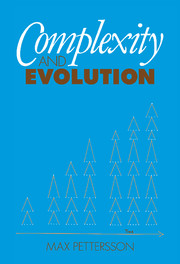Book contents
- Frontmatter
- Contents
- Foreword by Joseph Needham, FRS
- Preface
- Acknowledgements
- 1 Natural and other hierarchies
- 2 Major integrative levels
- 3 Some logarithmic forms of display
- 4 Physical range of integrated natural entities
- 5 Biological range of integrated natural entities (first part)
- 6 Biological range of integrated natural entities (second part)
- 7 Social range of integrated natural entities
- 8 Human societies (first part)
- 9 Human societies (second part)
- 10 Acceleration in evolution
- 11 Further allied accelerations
- 12 Aspects of number
- 13 Aspects of mass
- 14 Positive skewness
- 15 Quantitative conclusions
- Bibliography
- Index
3 - Some logarithmic forms of display
Published online by Cambridge University Press: 18 January 2010
- Frontmatter
- Contents
- Foreword by Joseph Needham, FRS
- Preface
- Acknowledgements
- 1 Natural and other hierarchies
- 2 Major integrative levels
- 3 Some logarithmic forms of display
- 4 Physical range of integrated natural entities
- 5 Biological range of integrated natural entities (first part)
- 6 Biological range of integrated natural entities (second part)
- 7 Social range of integrated natural entities
- 8 Human societies (first part)
- 9 Human societies (second part)
- 10 Acceleration in evolution
- 11 Further allied accelerations
- 12 Aspects of number
- 13 Aspects of mass
- 14 Positive skewness
- 15 Quantitative conclusions
- Bibliography
- Index
Summary
By now we have covered all the more general points involved in the idea of the natural hierarchy, and of its nine major integrative levels. A number of points of detail will need to be filled in, as in Chapters 4–9, before the quantitative results of Chapters 10–14 can be attained. But before discussing atoms and molecules in Chapter 4, it seems appropriate – for the benefit of non-specialist readers – to give some idea of how large such things as atoms and molecules actually are, and how their sizes compare with those of viruses and cells. At the same time we can briefly introduce some methods of logarithmic plotting which are rather useful for the display of the weight (or mass) of various entities, and their parts, as well.
Lengths of smaller entities
Starting from the left-hand end of a ruler, each movement to the right by a standard distance (say an inch or a centimetre) represents an additive increase of length by that standard unit. But the vertical scale in Fig. 3.1 is arranged differently. Each movement upwards, from one peg to the next peg above, represents a multiplication by a constant factor, in fact by 10, thus the distance on the scale between 1 millimetre and 1 centimetre is the same as that between 1 nanometre and 10 nanometres. We shall be using this kind of logarithmic scale frequently, so for those who wish for it, a little more information about the metric scale of lengths, and logarithmic plotting, is offered in an Appendix to this chapter.
Information
- Type
- Chapter
- Information
- Complexity and Evolution , pp. 16 - 25Publisher: Cambridge University PressPrint publication year: 1996
